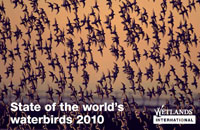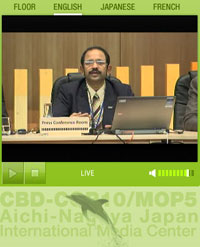Wetlands International presents "State of the World's Waterbirds 2010" at CBD COP in Nagoya, Japan
 Nagoya,
Nagoya,
Japan 21 October 2010 - A new publication entitled
"State of the World's Waterbirds 2010" was launched
by Wetlands International today at the Conference of the
Parties to the Convention on Biological Diversity being
held 18-29 October 2010 in Nagoya, Japan.
The publication gives a comparative overview of the status
of waterbird populations broken down by the world's major
flyways. It highlights the changes in the status of waterbird
populations in each of these flyways between 1976 and
2005.
The analysis conducted by Wetlands International for
this report shows that the status of waterbird populations
remains poor and that globally 44% of known populations
are decreasing and only 17 % are increasing.
"While the global trend is still very alarming,
the data analysis presented in The State of the World's
Waterbirds 2010 shows a partial improvement in waterbird
status in some regions, particularly in North America
and Europe." said Bert Lenten, Executive Secretary
of the African-Eurasian Migratory Waterbird Agreement.
 According
According
to the report, the general conservation status of waterbird
populations is most favourable in North America, in Europe
and in Oceania, while the status remains least favourable
in Africa, South America and particularly in Asia, where
62% of known populations are decreasing or extinct and
only 10% are increasing.
"It is interesting to note that the report suggests
that the more favourable trend status of waterbird populations
seem to occur in regions with relatively strong legislative
and administrative frameworks in place" underlined
Lenten.
For the "Africa-West Eurasia" flyway, the report
points out the contrast between the deteriorating status
of long-distance migrant populations and the stable or
improving status of residents and short-distance migrants,
noting that the "marked difference between flyways
and regions that include populations breeding and/or wintering
in the European Union and populations elsewhere in the
region suggests the positive influence of implementing
strong conservation policies in the EU."
“For the African-Eurasian flyway the report confirms
what was also recognized by our last Meeting of the Parties
(MOP) in 2008 when the
African Initiative under AEWA was launched:
The focus needs to be on Africa and we have to do more
to conserve long distance migrants and also pay more attention
to the inter-African migrants” concludes Lenten.
In addition to summarizing what is known about the status
of waterbird populations in different parts of the world,
the publication also includes a summary of the pressures
which most threaten these populations and the sites and
habitats they use along all of the world’s major
flyways.
Further Information:
- Download
the full publication: "State of the World's Waterbirds
2010" (PDF Document, 5 MB) - Wetlands
International Press Release: State of the World’s
Waterbirds: in trouble in Asia, recovering in ‘the
West’ (21 October 2010) - Webcast
of the Press Conference: "State of the World's Waterbirds"
(21 October 2010) - Side
Event Webcast of the EAAFP Secretariat & Ministry
of the Environment of Japan: "Responding to the biodiversity
challenge of the East Asian - Australasian Flyway"
(21 October 2010)
- Introduction
to the AEWA African Initiative
Last updated on 16 June 2014


